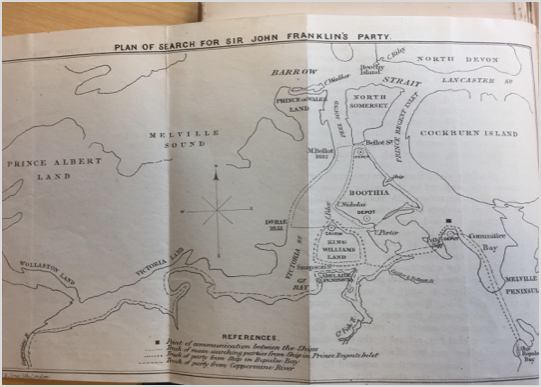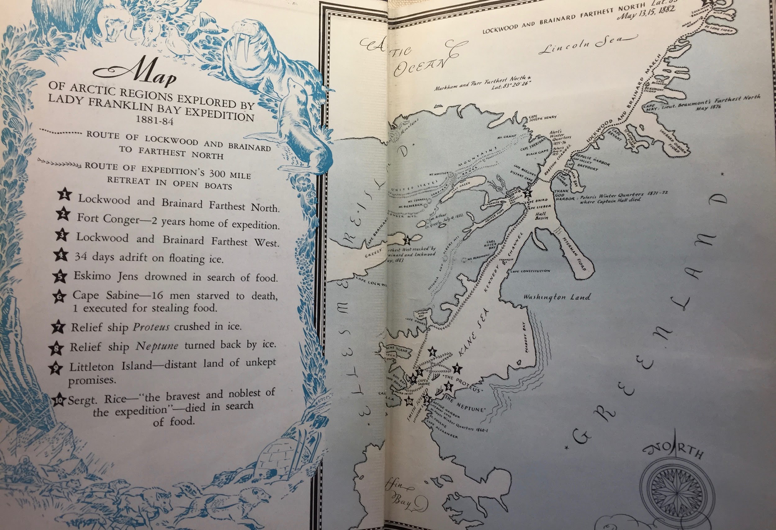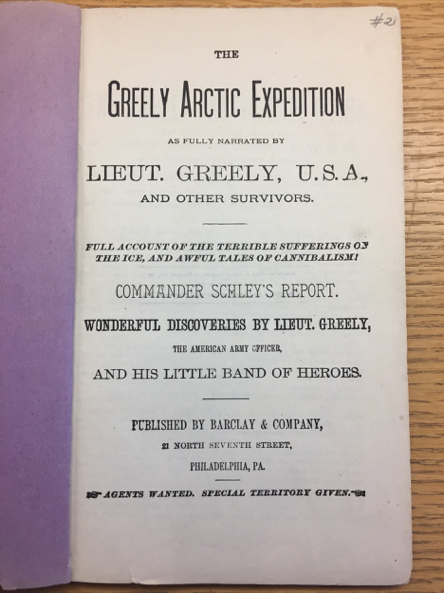- Parsons, James. Reflections on the Mysterious Fate of Sir John Franklin. London: J.F. Hope, 1857. (pgs. 79, 84) [Stefansson G662 .P26]
 This map traces the author’s suggested route to locate John Franklin’s party. The reference lines on the map lead to areas that are either unexplored or have not been searched. Following the image, the author concludes that using this guide would “complete the search to the satisfaction of Great Britain and the world in general.” The author wants to find the documents and research from the Franklin expedition and in doing so, limit the constant speculation from England.
This map traces the author’s suggested route to locate John Franklin’s party. The reference lines on the map lead to areas that are either unexplored or have not been searched. Following the image, the author concludes that using this guide would “complete the search to the satisfaction of Great Britain and the world in general.” The author wants to find the documents and research from the Franklin expedition and in doing so, limit the constant speculation from England.
- Armstrong, Alexander. A Personal Narrative of the Discovery of the North-West Passage. London: Hurst and Blackett, 1857. (pgs. 278-279) [Stefansson G665 1850 .C7]
 October 31st, 1850 — “The Northwest passage is incontrovertibly established.” Written by a surgeon aboard the HMS Investigator, this narrative describes the search for Sir Franklin and the Northwest Passage. Here, the discovery that the Atlantic and Pacific are undoubtedly connected fills the crew with “an indescribable feeling of pride and pleasure.” They believe they will be able to pass the northernmost point during the next summer, however the ship never makes it that far. After two more winters spent stuck in ice floes, the crew abandons the ship and begins a trek to Melville Island. Remarkably, they are discovered and rescued there by another English ship whose assignment was to find both Sir Franklin and the HMS Investigator.
October 31st, 1850 — “The Northwest passage is incontrovertibly established.” Written by a surgeon aboard the HMS Investigator, this narrative describes the search for Sir Franklin and the Northwest Passage. Here, the discovery that the Atlantic and Pacific are undoubtedly connected fills the crew with “an indescribable feeling of pride and pleasure.” They believe they will be able to pass the northernmost point during the next summer, however the ship never makes it that far. After two more winters spent stuck in ice floes, the crew abandons the ship and begins a trek to Melville Island. Remarkably, they are discovered and rescued there by another English ship whose assignment was to find both Sir Franklin and the HMS Investigator.
- Randall, Harry. Conquest of the Northwest Passage: a treatise. Minneapolis: Murphy-Travis, 1907. [Stefansson G640 .R18]
 This short book/pamphlet outlines the history of the search for the Northwest Passage, spending a good deal of its short length detailing Franklin’s expeditions within the Arctic and the subsequent search to find him. Published in 1907, it provides readers with a good deal of information regarding the Northwest Passage and the Arctic. It was published following Roald Amundsen’s successful sailing of the Northwest Passage between 1903 and 1906 with the intention of informing the general public of just how historic such an event was at the time. In the selected passage, Harry Randall writes that “For four hundred years and more the northwest passage has remained the one great geographical unaccomplished problem.” This captures just how long people had strived for and failed to find the Northwest Passage. There is a sense of the history of this mythical place. Shortly thereafter, the pamphlet concludes with the lines, “[Amundsen] started westward and emerged through Behring strait on Sept. 1st, 1906, having thus accomplished the conquest of the northwest passage.” This final journey comes across as simple but the pamphlet makes clear just how much this voyage had accomplished.
This short book/pamphlet outlines the history of the search for the Northwest Passage, spending a good deal of its short length detailing Franklin’s expeditions within the Arctic and the subsequent search to find him. Published in 1907, it provides readers with a good deal of information regarding the Northwest Passage and the Arctic. It was published following Roald Amundsen’s successful sailing of the Northwest Passage between 1903 and 1906 with the intention of informing the general public of just how historic such an event was at the time. In the selected passage, Harry Randall writes that “For four hundred years and more the northwest passage has remained the one great geographical unaccomplished problem.” This captures just how long people had strived for and failed to find the Northwest Passage. There is a sense of the history of this mythical place. Shortly thereafter, the pamphlet concludes with the lines, “[Amundsen] started westward and emerged through Behring strait on Sept. 1st, 1906, having thus accomplished the conquest of the northwest passage.” This final journey comes across as simple but the pamphlet makes clear just how much this voyage had accomplished.
- Rowland James, Bessie. Six Came Back: The Arctic Adventure of David L. Brainard. New York: The Bobbs-Merrill Company, 1940. (map) [Stefansson G670 1881 .G717]
 This book tells the story of the Lady Franklin Bay expedition led by Lieutenant Greely as they attempted to do research of the Arctic region. This expedition also had people reach a new farthest north point at the time. The book is mostly composed of the journals of David Brainard, a member of the expedition. The expedition ended up being a failure with only 6 of the 25 members making it back alive. Brainard takes us through the grueling conditions that the crew lived through and the horrifying situations they faced. It is a story of immense hardships but also a tale of the incredible ability of humans to survive.
This book tells the story of the Lady Franklin Bay expedition led by Lieutenant Greely as they attempted to do research of the Arctic region. This expedition also had people reach a new farthest north point at the time. The book is mostly composed of the journals of David Brainard, a member of the expedition. The expedition ended up being a failure with only 6 of the 25 members making it back alive. Brainard takes us through the grueling conditions that the crew lived through and the horrifying situations they faced. It is a story of immense hardships but also a tale of the incredible ability of humans to survive.
- The Greely Expedition as fully narrated by Lieut. Greely, U.S.A, and other survivors. Philadelphia: Barclay, 1884. (title page, pg. 19) [Stefansson G670 1881. G65]

 This is a short narrative written in 1884 to inform the United States public of Lieutenant Greely’s Arctic expeditions. It is narrated by Lieut. Greely and other survivors of the expedition, and it expresses the hardships they faced after relief ships were unable to reach them as planned. The narrative portrays the survivors as heroes despite the signs that they had to resort to cannibalism to survive. Having to resort to cannibalism to survive was a common controversial issue for stranded Arctic explorers of the time. The narrative, however, justifies their heroism with their scientific and exploratory accomplishments along with their resiliency when faced with the Arctic hardships.
This is a short narrative written in 1884 to inform the United States public of Lieutenant Greely’s Arctic expeditions. It is narrated by Lieut. Greely and other survivors of the expedition, and it expresses the hardships they faced after relief ships were unable to reach them as planned. The narrative portrays the survivors as heroes despite the signs that they had to resort to cannibalism to survive. Having to resort to cannibalism to survive was a common controversial issue for stranded Arctic explorers of the time. The narrative, however, justifies their heroism with their scientific and exploratory accomplishments along with their resiliency when faced with the Arctic hardships.